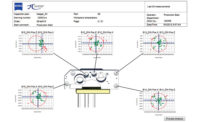Now in its seventh year, the study measures new-vehicle ownership satisfaction with 2008 and 2009 model-year vehicles in Mexico. Overall satisfaction is determined by measuring customer experiences in four factors: vehicle quality and reliability; vehicle appeal; dealership service; and ownership costs.
The study finds that differences between automotive brands are relatively small in the quality and reliability and ownership costs factors, but greater in vehicle appeal and dealership service. The gap between the highest-performing and lowest-performing models averages 59 points on a 1,000-point scale for vehicle quality and reliability and 64 points for ownership costs. In comparison, these differences are 78 points in the vehicle appeal factor and 80 points in the dealership service factor.
"It appears as though automakers, as a whole, are focusing on satisfaction in just one or two aspects of the ownership experience, which means there is ample opportunity for differentiation in areas where there is demonstrated weakness," said Richard Cooper, vice president of Canada and Latin America operations at J.D. Power and Associates.
According to Cooper, light-vehicle sales in Mexico are showing signs of recovery, but the industry is still far from achieving the peak sales recorded between 2005 and 2006, when sales reached approximately 1.1 million units annually. As sales continue to increase, competition in the market is expected to intensify as new models enter the market and automakers improve new-vehicle design, quality and dealership service.
The study examines new-vehicle models according to vehicle segment. The number of automotive brands that receive awards has increased to 11 in 2010 from seven in 2009. The highest-ranking models by segment are:
The study also finds a strong relationship among each of the four components of ownership satisfaction and the likelihood that a customer will consider the same brand of vehicle when making a future purchase decision. For example, 80% of owners who are delighted with their experience of the vehicle's quality and reliability say they "definitely will" purchase the same brand in the future. However, among less-satisfied customers, only 54% say the same.
"While the fundamentals of having appealing and high-quality products will remain vital, manufacturers that can take a longer-term view of the customer experience are likely to be the most successful," said Cooper. "Seemingly minor differences in satisfaction in individual factors may increase the risk that the customer will switch to a different brand in the future, causing the manufacturer to expend resources to 'conquest' new customers--a much more expensive proposition than maintaining a satisfied customer. Both manufacturers and dealerships play vital roles in this effort. Customer retention, both in terms of brand loyalty and service loyalty, must become priorities to sustain dealerships and avoid the high cost of continually having to conquest new customers."
The 2010 Mexico Vehicle Ownership Satisfaction Study includes responses from 6,578 owners of 2008 and 2009 model-year vehicles who purchased their vehicles between January 2008 and June 2009. Respondents were interviewed in seven of Mexico's largest auto markets-- Guadalajara, Hermosillo, Mexico City, Monterrey, Puebla, Querétaro and Veracruz--and were asked to evaluate their experiences during the first 12 to 30 months of ownership. The study was fielded between June and October 2010.


